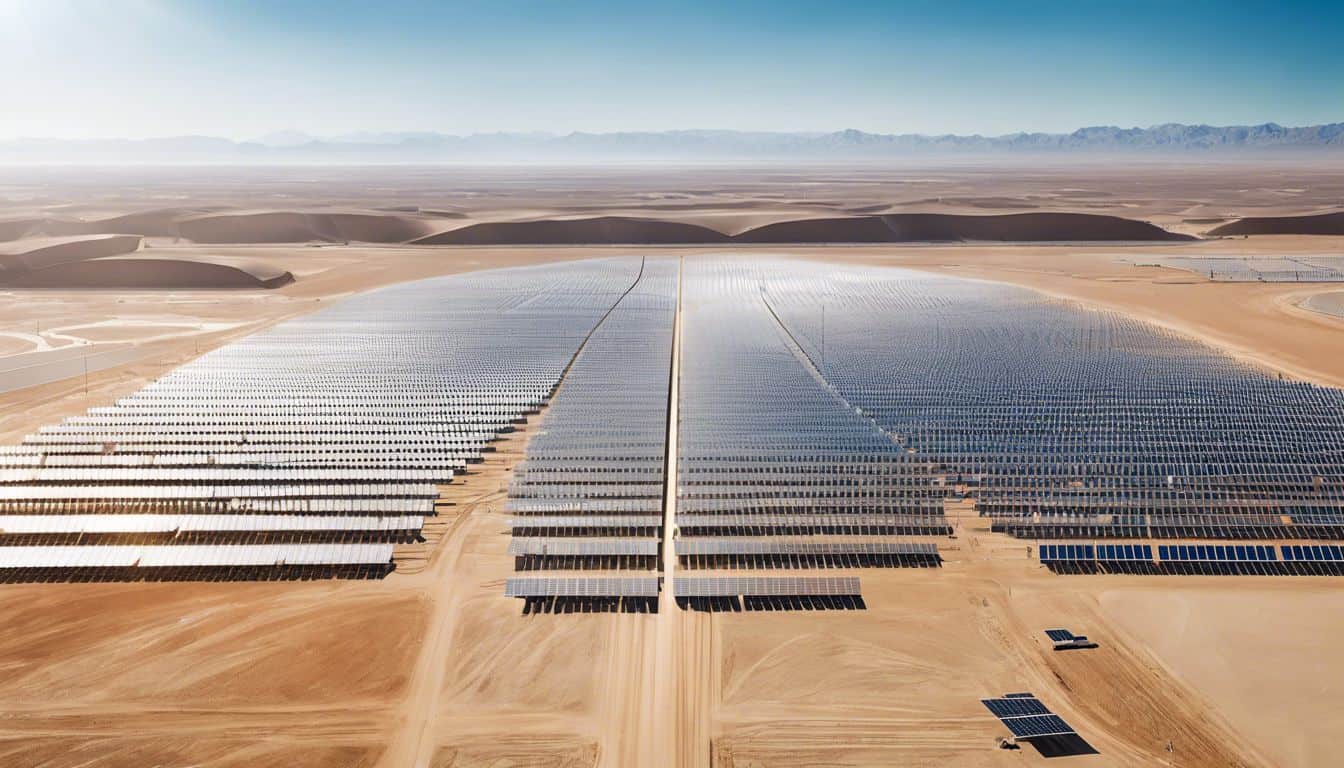In the quest for a sustainable energy future, integrating various renewable energy sources has become increasingly important. Concentrated Solar Power (CSP) stands out as a versatile technology that can work synergistically with other renewables, enhancing overall system efficiency and reliability. This article explores the potential of CSP integration and its role in creating a more robust and sustainable energy landscape.
Understanding CSP Technology
Concentrated Solar Power harnesses the sun’s energy by using mirrors or lenses to concentrate a large area of sunlight onto a small area. This concentrated light is then converted into heat, which drives a heat engine connected to an electrical power generator. CSP systems come in various forms, including parabolic troughs, power towers, and dish/engine systems, each with its unique advantages.
One of CSP’s key strengths is its ability to store thermal energy, allowing for power generation even when the sun isn’t shining. This feature sets it apart from other renewable sources and makes it an excellent candidate for integration with intermittent renewables. For a deeper dive into the latest advancements in this field, check out this guide to concentrated solar power innovations.

Synergies between CSP and Photovoltaic (PV) Solar
Integrating CSP with Photovoltaic (PV) solar systems creates a powerful synergy. While PV systems are more efficient at converting direct sunlight into electricity, CSP excels in storing energy and providing dispatchable power. Hybrid CSP-PV systems leverage the strengths of both technologies:
- PV provides efficient power generation during peak sunlight hours.
- CSP’s thermal storage capabilities ensure power availability during cloudy periods or at night.
Several projects worldwide have successfully demonstrated this integration. For instance, the Noor Midelt project in Morocco combines CSP and PV to provide reliable, round-the-clock renewable energy.
CSP and Wind Power Integration
The combination of CSP and wind power addresses one of the main challenges of renewable energy: intermittency. Wind power is often strongest during evening hours or at night when solar resources are unavailable. By integrating CSP with wind power:
- CSP’s thermal storage can smooth out the variability of wind power.
- The combined system can provide a more consistent power output throughout the day and night.
Geographical considerations play a crucial role in this integration, as areas with both strong solar and wind resources are ideal for such hybrid systems.
Thermal Energy Storage in CSP Systems
CSP’s thermal energy storage capability is a game-changer in its integration with other renewables. Concentrated solar power storage solutions have seen significant advancements, allowing for longer storage durations and higher efficiencies. This storage capability:
- Enhances grid stability by providing dispatchable power.
- Allows for better matching of energy supply with demand.
- Increases the overall capacity factor of renewable energy systems.
CSP in Multi-Technology Renewable Energy Systems
The versatility of CSP extends to its potential integration with other renewable sources:
- Hydropower: CSP can complement hydropower systems, especially in regions facing water scarcity.
- Geothermal: The combination of CSP and geothermal energy can provide stable baseload power with enhanced efficiency.
- Biomass: CSP-biomass hybrid systems can offer reliable power generation while utilizing agricultural waste.
Grid Integration and Smart Energy Management
Integrating CSP with other renewables requires sophisticated grid management and control systems. Artificial intelligence is playing a crucial role in optimizing concentrated solar power operations, enabling more efficient integration with the grid and other renewable sources. These advanced systems:
- Balance supply and demand in real-time.
- Optimize the use of storage capabilities.
- Enhance the overall stability of grids with high renewable penetration.
Economic and Environmental Benefits
The synergistic approach to renewable energy integration offers significant economic and environmental benefits:
- Cost reductions through shared infrastructure and increased efficiency.
- Higher overall system reliability and capacity factors.
- Reduced environmental impact compared to standalone systems.
Challenges and Future Outlook
While the integration of CSP with other renewables shows great promise, several challenges remain:
- Technical complexities in integrating different technologies.
- Need for supportive policies and regulatory frameworks.
- Ongoing research requirements to optimize hybrid systems.
Despite these challenges, the future outlook for integrated renewable energy systems featuring CSP is bright. As technology advances and costs decrease, we can expect to see more innovative hybrid projects that leverage the strengths of various renewable sources.

Conclusion
The synergy between Concentrated Solar Power and other renewable energy sources represents a significant step forward in our journey towards a sustainable energy future. We can create more reliable, efficient, and environmentally friendly power systems by harnessing the complementary strengths of different technologies. As research continues and more projects demonstrate the viability of this approach, integrated renewable energy systems featuring CSP are poised to play a crucial role in meeting our global energy needs while combating climate change.
FAQS
How does Concentrated Solar Power (CSP) work?
CSP systems harness the sun’s energy using mirrors or lenses to concentrate sunlight onto a receiver:
- The concentrated sunlight heats a fluid, such as molten salt or synthetic oil, to high temperatures
- This hot fluid is used to generate steam, which drives a turbine connected to an electricity generator
- The thermal energy can also be stored for later use, allowing CSP plants to produce electricity even when the sun isn’t shining
- By focusing the sun’s rays, CSP can achieve higher temperatures and efficiencies than traditional solar panels
What are the advantages of combining CSP with other renewable energy sources?
Integrating CSP with other renewables offers several key benefits:
- CSP’s ability to store energy helps balance the intermittency of wind and solar PV, providing a more stable and reliable power supply
- Combining CSP with geothermal energy can create a baseload power source that operates 24/7, reducing the need for fossil fuel backup
- Hybrid systems that use CSP alongside biomass or natural gas can improve overall plant efficiency and reduce costs
- By leveraging the strengths of each technology, these synergies create a more robust and sustainable energy mix
How can advancements in materials science and technology improve CSP performance?
Ongoing research and development in materials science and technology are crucial for enhancing CSP’s efficiency and cost-effectiveness:
- New heat transfer fluids, such as supercritical CO2, can operate at higher temperatures and pressures, increasing power cycle efficiency
- Advanced coatings and materials for mirrors and receivers can improve solar reflectivity and thermal stability, reducing energy losses
- Smart control systems and predictive maintenance algorithms can optimize plant performance and reduce downtime
- These innovations help drive down the cost of CSP and make it more competitive with other energy sources
What is the global market outlook for CSP in the coming years?
The global CSP market is poised for significant growth in the near future:
- By 2025, the worldwide CSP market is projected to surpass $10 billion, driven by increasing demand for clean energy and technological advancements
- Regions with high solar irradiance, such as the Middle East, North Africa, and the American Southwest, are expected to see the most rapid CSP deployment
- As CSP costs continue to decline and efficiencies improve, it will become an increasingly attractive option for utilities and investors looking to expand their renewable energy portfolios
How can the synergy between CSP and other renewables contribute to job creation and economic growth?
The integration of CSP with other renewable technologies has the potential to drive significant economic benefits:
- The construction, operation, and maintenance of CSP plants and hybrid renewable energy systems create jobs across a wide range of sectors, from manufacturing to engineering
- The development of local supply chains for CSP components and services can stimulate economic activity and support small businesses
- By reducing reliance on imported fossil fuels and increasing energy independence, CSP and other renewables can improve countries’ trade balances and energy security
- The transition to a clean energy economy powered by CSP and other renewables can create new opportunities for innovation, investment, and sustainable growth

Leave a Reply